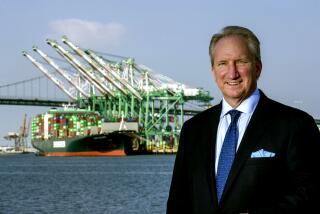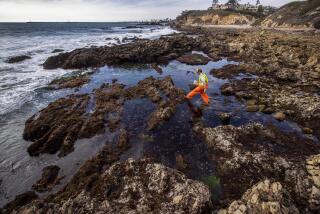A system to keep tabs on ships
- Share via
The Canadian boat was salmon fishing in the Gulf of Alaska last summer when it ran aground, ripped a hole in its hull and began to take on water.
Its skipper and two crewmen were about to benefit from an eye in the sky.
Using an inexpensive private system that tracks vessels by satellite, personnel at the U.S. Coast Guard’s district headquarters in Juneau, Alaska, turned to a computer screen showing an image of the coastline from Puget Sound to the Aleutian Islands.
Superimposed on the display were several vessels. One of them, an oceangoing tug towing cargo barges, was near the foundering fishing boat. The Coast Guard contacted the tug.
“Because they knew exactly where we were, they asked could we divert over and pick up these guys,” said David Byrne, operations manager for Seattle-based Alaska Marine Lines, owner of the tug that conducted the impromptu rescue. “We took them back to shore and everyone was happy.”
The Automated Secure Vessel Tracking System has proven itself to businesses around the world. It gave real-time information to oil companies as Hurricane Katrina raged in 2005, helping them follow oil platforms that had been torn from their moorings. It has tracked ships in distress far out to sea.
But the system is getting more attention these days because of who isn’t using it: the Coast Guard. Juneau is one of the few Coast Guard district headquarters that subscribes to the system.
Congress ordered the Coast Guard to begin testing by Sunday a system that would track all ships approaching U.S. ports. The Coast Guard says a system will be in place, but critics are concerned that it will prove to be insufficient.
The Coast Guard and Maritime Transportation Act of 2006 says the Coast Guard, part of the Department of Homeland Security, must begin a three-year pilot program of a system capable of tracking 2,000 ships at once “to aid maritime security and response to maritime emergencies.” The latter is of particular interest to shipping line insurers, who note that a single containership in distress at sea represents, with its cargo, a potential $2-billion loss.
Some lawmakers are trying to convince the Coast Guard that the answer already exists in the maritime industry’s vessel tracking system.
The desire for long-range tracking is an acknowledgment that the current traffic control system, which notes the arrival of ships from foreign shores, is risky in a post-9/11 world. Ship captains are required only to file a notice four days before hitting port, telling the Coast Guard about the ship’s cargo and the identities of its crew, among other information.
Rep. Loretta Sanchez (D-Santa Ana), who chairs the House subcommittee on Border, Maritime and Global Counterterrorism, said that “most Americans probably assume that we already track all vessels coming to American ports. Unfortunately we do not.”
Sen. Charles E. Schumer (D-N.Y.) said he wanted the Coast Guard to sign up for the existing maritime system “immediately and allow us to keep a vigilant watch over our ports.... Despite scores of ships from every corner of the globe entering the New York port every year, we still don’t have a comprehensive tracking system in place to closely monitor whether it’s a friend or a foe coming to our shores.”
Dana A. Goward, the Coast Guard’s director for maritime domain awareness, acknowledged that much work needed to be done.
“Generally our maritime traffic control system is where the aviation industry was in the 1920s and 1930s,” Goward said. “We think we are making progress, but the nation needs to do better. We are confident we are getting better all the time.”
Goward said that the Coast Guard would have “a combination of classified and unclassified solutions that will allow us to exceed” congressional requirements by Sunday’s deadline.
The Coast Guard has been relying primarily on a radio-based tracking system. Its new system is expected to use satellite technology, but not immediately and then only on a limited basis, Schumer said.
The system being pushed by Schumer, Sanchez and other members of Congress, however, has been used to monitor ship movement for the last five years by a coalition of nonprofit maritime organizations.
The system relies on emergency beacons that already are fixtures on most commercial vessels. A software program “pings” the ship via satellite and retrieves data such as the name of the vessel, its owner, its latitude and longitude, its speed and its course. It can also track a ship’s route across the ocean, allowing observers to know whether the ship stopped and met another vessel at sea or diverted to a port that wasn’t on its usual route.
“Many shipping lines have some form of tracking, but these are very individualized, proprietary looks,” said Manny Aschemeyer, the retired ship captain who runs the Marine Exchange of Southern California, which tracks vessel movements into and out of the ports of Los Angeles and Long Beach.
“We want a global tracking system of vessels,” he said. “The questions we ask are: Do we know what is headed our way? Do we know where they are coming from for sure? And if they are in trouble, do we know precisely where they are?”
The Marine Exchange of Southern California is one of 12 organizations in the U.S. and Canada that together monitor about 85% of the ocean cargo heading to and from North America.
The tracking system was created in 1999 by a small family-run company called Yukon Fuel Co. in Anchorage to keep tabs on its tugs and barges as they supplied fuel and freight to isolated Alaskan villages, fishing camps and mining sites. The software proved so popular that the family sold Yukon and formed Secure Asset Reporting Services Inc. to market the system, said Clayton Shelver, the company’s chief executive.
“We started working with the Marine Exchanges to see how we could use this,” Shelver said. The Bellevue, Wash.-based company, which expects to take in $14 million in sales this year, has about 400 clients worldwide.
The Coast Guard isn’t the only player that still needs convincing. Most major shipping companies haven’t signed on either. So far, only Taiwan-based Evergreen Marine Corp. has agreed to test it.
“We know where our ships are,” said Wesley J. Brunson, a U.S.-based executive for Evergreen Marine. “But if it is dealing with security, we want to be good neighbors.”
Seattle-based Island Tug & Barge Co. uses the Secure Asset system to keep an eye on its 15 vessels, which have hauled cargo as far as Tahiti.
When company President Frank Ellefsen heard that one of his vessels had snagged its propeller on an abandoned fishing net, he was able to watch on his computer screen and see the moment when it restarted its engines and was underway again.
Ellefsen said the first thing he does in the morning is use the system to check where his boats are. The last thing before leaving at night? He checks on them again.
“It helps me sleep at night,” Ellefsen said.
*
More to Read
Sign up for Essential California
The most important California stories and recommendations in your inbox every morning.
You may occasionally receive promotional content from the Los Angeles Times.











